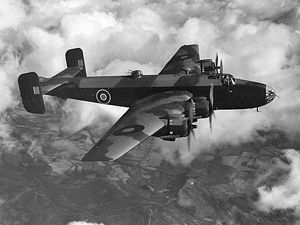Halifax bomber
| Halifax | |
|---|---|
 |
|
| Handley Page Halifax B.III showing the later rectangular fins and Bristol Hercules radial engines | |
| Role | Heavy bomber |
| National origin | United Kingdom |
| Manufacturer | Handley Page |
| First flight | 25 October 1939 |
| Introduction | 13 November 1940 |
| Retired | 1961 (Pakistani Air Force) |
| Status | Retired |
| Primary users |
Royal Air Force Royal Canadian Air Force Royal Australian Air Force Free French Air Force |
| Produced | 1940–1945 |
| Number built | 6,176 |
The Handley Page Halifax was a British four-engined heavy bomber of the Second World War. It was developed by Handley Page as a contemporary of the Avro Lancaster, both bombers having been developed to the same specification, as well as the Short Stirling, all three aircraft being four-engined heavy bombers adopted by the Royal Air Force (RAF) during the same wartime era.
The Halifax has its origins in the twin-engine HP56 proposal of the late 1930s, which had been produced in response to the British Air Ministry's Specification P.13/36 for a capable medium bomber for "world-wide use". The HP56 was ordered as a backup to the Avro 679, both designs being designed to use the underperforming Rolls-Royce Vulture engine; the Handley Page design was altered at the Ministry to a four-engine arrangement, which was powered by the iconic Rolls-Royce Merlin engine, while the rival Avro 679 was produced as the twin-engine Avro Manchester which, while regarded as unsuccessful mainly due to the Vulture engine, was a direct predecessor of the famed Avro Lancaster. Both the Lancaster and the Halifax would emerge as capable four-engined strategic bombers of which thousands would be manufactured and operated by the RAF and several other services throughout the course of the conflict.
On 25 October 1939, the Halifax performed its maiden flight, and entered service with the RAF on 13 November 1940. It quickly became a major component of Bomber Command, performing routine strategic bombing missions against the Axis Powers, many of which were performed at night. Arthur Harris, the Air Officer Commanding-in-Chief of Bomber Command, described the Halifax as being inferior to the rival Lancaster, in part due to its inability to carry larger individual bombs such as the 4,000 pound "Cookie" blast bomb. Nevertheless, production of the bomber continued until April 1945. During its service with Bomber Command, Halifaxes flew a total of 82,773 operations and dropped 224,207 tons of bombs, while 1,833 aircraft were lost. The Halifax was also operated in large numbers by other Allied and Commonwealth nations, such as the Royal Canadian Air Force (RCAF), Royal Australian Air Force (RAAF), Free French Air Force and Polish forces.
...
Wikipedia
